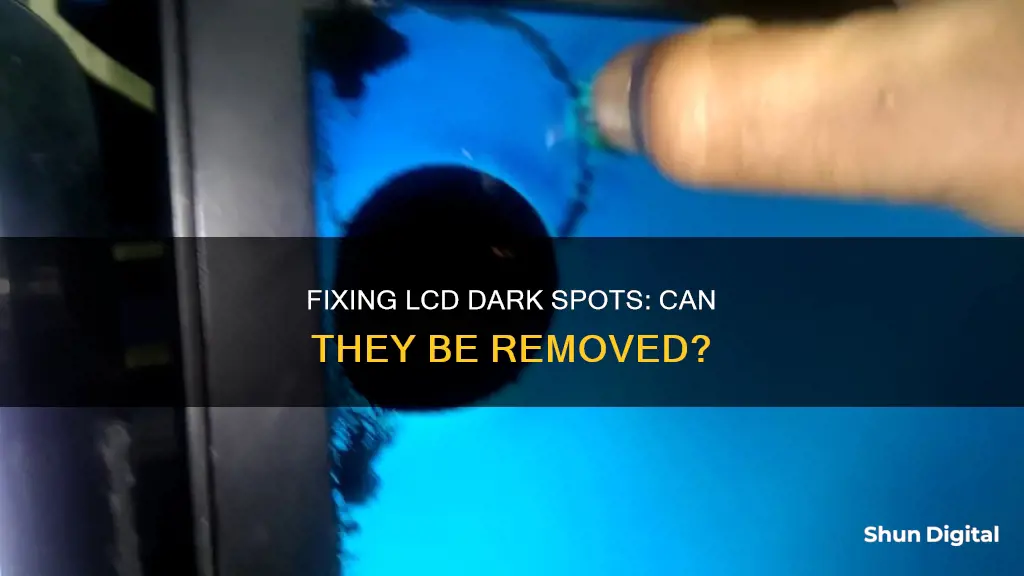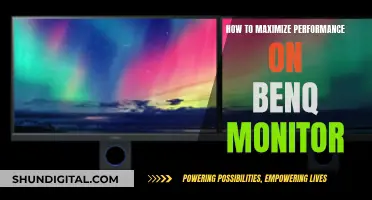
Dark spots on an LCD monitor can be caused by a number of issues, including dirt, dead pixels, physical damage, or manufacturing defects. While some of these issues can be resolved with simple fixes such as cleaning the screen or adjusting settings, others may require more intrusive methods or professional repair. Understanding the causes of dark spots on LCD screens can help users take the necessary precautions to prevent them from occurring and maintain the clarity and quality of their viewing experience.
| Characteristics | Values |
|---|---|
| Cause | Superficial dirt or debris, stuck pixel, dead pixel, manufacturing defects, physical damage, ageing and wear, backlight bleeding, software issues |
| Fixes | Clean the screen, verify manufacturer support and warranties, use pixel fixing software, gently massage the affected area, use pixel exerciser apps, apply heat, professional repair, adjust backlight settings, turn the light sensor setting on, change the power-saving setting, support the back of the TV, full software reset |

Dead pixels
There are a few methods to fix a stuck pixel, but it is important to note that you cannot fix a dead pixel. To identify whether a pixel is stuck or dead, view your monitor in different colour palettes. A stuck pixel will appear in any of the colours that its three sub-pixels (red, green, and blue) can form, depending on their functionality and brightness.
- Use a third-party tool to flash the pixel with multiple colours. Tools such as UDPixel (Windows) or LCD (online) can help identify and fix stuck pixels.
- Try a manual method by rubbing the stuck pixel with a damp cloth or a soft, pointy item, like the rubber/eraser at the end of a pencil.
- Gently press on the affected area with a lint-free cloth. This method of redistributing the liquid crystal can help revive stuck pixels.
- Use pixel exerciser apps that display rapidly changing colours to unstick pixels.
- Apply a small amount of heat to the screen using a heat gun or a hairdryer on low heat.
If none of these methods work, you may need to contact a qualified technician or consider replacing your screen.
How to Remove the 60Hz Display on ASUS Monitors
You may want to see also

Stuck pixels
A stuck pixel is a bright dot of colour that fails to update when neighbouring pixels change. They are most noticeable when the rest of the screen is black. Stuck pixels are often the result of manufacturing defects, physical damage, or ageing and wear.
There are several methods you can try to fix a stuck pixel:
- Pixel-fixing software: Software like JScreenFix, DPT 2.20, UDPixel 2.1, and LCD Scrub can help fix stuck pixels by rapidly turning them on and off.
- Pressure method: Using a damp washcloth and a pen, pencil, or similar instrument, apply gentle pressure to the exact location of the stuck pixel while turning on the screen.
- Tapping method: Using a pen with a rounded end or a pencil eraser, gently tap on the stuck pixel until it starts to flicker.
- Heat method: Using a hairdryer or heat gun on low heat, apply a small amount of heat to the screen around the stuck pixel.
- Professional repair: If all else fails, consult a qualified technician to examine and repair or replace the screen.
Monitoring PCI Bus Usage: Linux Command Line Essentials
You may want to see also

Physical damage
Dark spots on an LCD screen can be annoying as they interfere with the quality and clarity of the images. These spots can occur due to several reasons, one of which is physical damage. Physical damage to the LCD screen can cause internal damage, leading to black spots appearing on the screen. This can be caused by dropping the device, rough handling, or placing heavy objects on the screen or computer.
To prevent physical damage to your LCD screen, it is important to handle your device with care and avoid applying too much pressure to the screen. Additionally, it is recommended to reduce the amount of time spent on static images by using screensavers or power-saving settings. This can help reduce the risk of physical damage and maintain the quality of your LCD screen.
If your LCD screen has physical damage and black spots appear, there are a few potential solutions you can try. Firstly, verify if your device is still under warranty and contact the manufacturer's customer support for assistance. They may be able to provide a repair or replacement if the issue is covered under the warranty. If the warranty has expired or does not cover physical damage, you may need to explore other options.
In some cases, you can try a gentle massage technique to fix the black spots. Use a lint-free cloth to gently press on the affected area. This method can sometimes help redistribute the liquid crystal and revive stuck pixels. However, it is important to be cautious and not apply too much pressure, as it may further damage the screen.
If the issue persists or you are uncomfortable performing the gentle massage technique, it is best to consult a qualified technician. They will be able to examine the screen, determine the extent of the physical damage, and provide professional repair services. They may be able to replace or fix the damaged pixels to restore your LCD screen to its original condition.
Firefox and User Privacy: Monitoring Usage and Data
You may want to see also

Manufacturing defects
Dark spots on an LCD screen can be a result of manufacturing defects. During the manufacturing process, pixels may become dead or stuck, leading to black spots on the screen. These dead pixels are individual pixels that are incapable of displaying any colour and may show up as black dots. Stuck pixels, on the other hand, are pixels that remain stuck on a single colour, often displaying as bright or coloured spots.
If you suspect that your LCD screen has dark spots due to manufacturing defects, it is recommended to verify manufacturer support and warranties. Contact the manufacturer's customer support and inquire about possible repair or replacement options. They may provide assistance if the issue is due to a manufacturing defect.
Additionally, you can try using pixel-fixing software or pixel exerciser apps. These solutions aim to fix stuck pixels by rapidly cycling through colours or displaying rapidly changing colours. While these methods may not work in all cases, they are worth trying before resorting to more intrusive techniques.
Monitoring CPU Usage: MSI Afterburner Guide
You may want to see also

Dirt or debris
Dark spots on an LCD screen can be caused by dirt or debris that has accumulated on the screen's surface over time. These spots are superficial and do not affect the performance or internal circuitry of the LCD. However, it is still a good idea to clean the screen with a damp, lint-free microfiber cloth to remove the spots. Ensure that the cloth is not soaked, and gently rub the screen until the spots disappear.
It is important to note that dark spots on an LCD screen can also be caused by other factors such as dead or stuck pixels, manufacturing defects, physical damage, or ageing and wear. In some cases, these issues may require professional repair or replacement. Additionally, there are software solutions available that can help fix stuck pixels by rapidly cycling through colours.
To prevent dark spots caused by dirt or debris, it is recommended to regularly clean your LCD screen. This can be done by gently wiping the screen with a microfiber cloth, being careful not to apply too much pressure. It is also advisable to avoid using any cleaning solutions, as they may damage the screen.
If the dark spots are not caused by dirt or debris, there are a few quick fixes you can try. These include restarting your device, changing the channel or input, and checking your cable connections. Additionally, adjusting your backlight and power-saving settings can also help reduce the appearance of dark spots.
In summary, while dark spots on an LCD screen can be unsightly and interfere with your viewing experience, they are often caused by superficial dirt or debris that can be easily cleaned. However, if the issue persists or is caused by other factors, further troubleshooting or professional assistance may be required.
The Perfect 24-Inch Monitor: ASUS VG248QE Review
You may want to see also
Frequently asked questions
Dark spots on an LCD monitor can be caused by a number of factors, including:
- Physical damage to the screen, such as dropping the device or applying too much pressure.
- Dead pixels, which occur when all three sub-pixels (red, green, and blue) are permanently turned off.
- Stuck pixels, where a pixel becomes stuck on a single colour, often due to manufacturing defects.
- Dirt or debris on the screen.
- Ageing and wear of the device over time.
There are several methods you can try to fix dark spots on your LCD monitor:
- Clean the screen with a microfiber cloth to remove any dirt or debris.
- Adjust the backlight settings on your monitor.
- Turn on the light sensor setting to adjust the brightness according to the ambient light in the room.
- Change the power-saving setting to low or high.
- Try a full software reset.
- Contact the manufacturer for support or a repair if the device is under warranty.
To prevent dark spots from appearing on your LCD monitor, it is important to handle the device with care and avoid applying too much pressure to the screen. Additionally, reduce the amount of time the screen displays static images by using screensavers or power-saving settings.
While dark spots on an LCD monitor can interfere with the quality and clarity of the display, they may not always indicate a serious problem. Superficial dirt or debris is a common cause of dark spots, which can be easily remedied by cleaning the screen. However, physical damage or pixel-related issues may require more intrusive methods or professional repair.
If the dark spots on your LCD monitor persist, it is recommended to seek professional assistance. A qualified technician can examine the screen and determine if any damaged components, such as stuck or dead pixels, need to be repaired or replaced.







